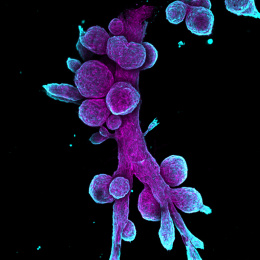Generating Models of Endometrial Tissues 4
Generating Models of Endometrial Tissues 4
Juan Gnecco, Alex Brown
MIT Department of Biological Engineering, Koch Institute at MIT
The uterus is one of the most complex and dynamic organ systems of the human body. In particular, the inner lining of the uterus, the endometrium, is responsible for the establishment of pregnancy and undergoes over 400 cycles of growth and shedding throughout a woman’s reproductive lifetime. Under the influence of hormones, such as estrogen and progesterone, it undergoes a cyclic and tightly orchestrated processes to allow embryo implantation. However, our understanding of this complex tissue’s function, as well as its reproductive diseases such as endometriosis and infertility, are poorly understood. Here, we see an endometrial organoid generated from human endometrium that mimics an endometrial gland in a synthetic matrix.
We took this image because it represented the tissue engineered endometrial glands that generated from endometrial organoids (middle image) and reached the surface to generate a connected monolayer, mimicking the glandular and luminal epithelial populations seen in vivo. This image is depth coded.






